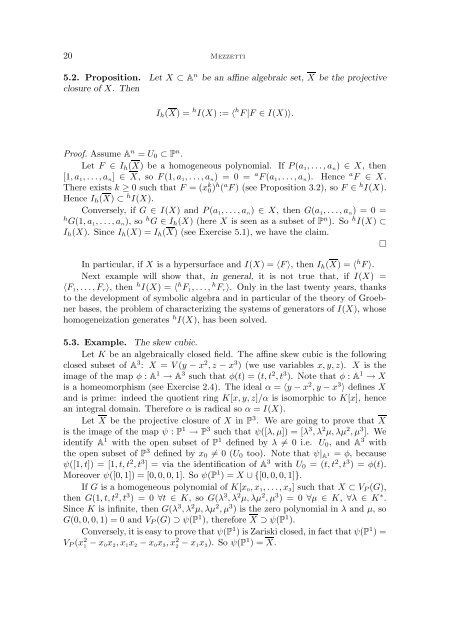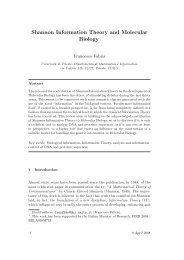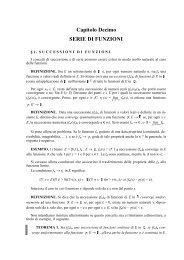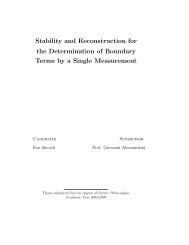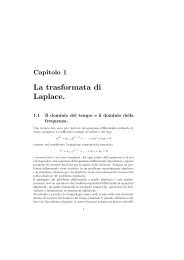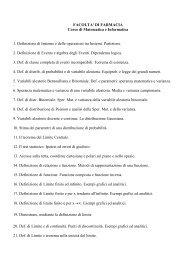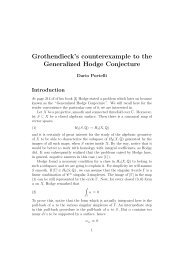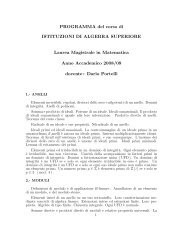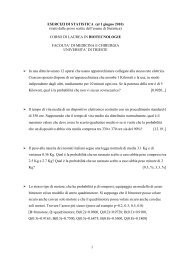INTRODUCTION TO ALGEBRAIC GEOMETRY Note del corso di ...
INTRODUCTION TO ALGEBRAIC GEOMETRY Note del corso di ...
INTRODUCTION TO ALGEBRAIC GEOMETRY Note del corso di ...
Create successful ePaper yourself
Turn your PDF publications into a flip-book with our unique Google optimized e-Paper software.
20 Mezzetti5.2. Proposition. Let X ⊂ A n be an affine algebraic set, X be the projectiveclosure of X. ThenI h (X) = h I(X) := 〈 h F |F ∈ I(X)〉.Proof. Assume A n = U 0 ⊂ P n .Let F ∈ I h (X) be a homogeneous polynomial. If P(a 1 , . . ., a n ) ∈ X, then[1, a 1 , . . ., a n ] ∈ X, so F(1, a 1 , . . ., a n ) = 0 = a F(a 1 , . . ., a n ). Hence a F ∈ X.There exists k ≥ 0 such that F = (x k 0 )h ( a F) (see Proposition 3.2), so F ∈ h I(X).Hence I h (X) ⊂ h I(X).Conversely, if G ∈ I(X) and P(a 1 , . . ., a n ) ∈ X, then G(a 1 , . . ., a n ) = 0 =h G(1, a 1 , . . ., a n ), so h G ∈ I h (X) (here X is seen as a subset of P n ). So h I(X) ⊂I h (X). Since I h (X) = I h (X) (see Exercise 5.1), we have the claim.□In particular, if X is a hypersurface and I(X) = 〈F 〉, then I h (X) = 〈 h F 〉.Next example will show that, in general, it is not true that, if I(X) =〈F 1 , . . ., F r 〉, then h I(X) = 〈 h F 1 , . . ., h F r 〉. Only in the last twenty years, thanksto the development of symbolic algebra and in particular of the theory of Groebnerbases, the problem of characterizing the systems of generators of I(X), whosehomogeneization generates h I(X), has been solved.5.3. Example. The skew cubic.Let K be an algebraically closed field. The affine skew cubic is the followingclosed subset of A 3 : X = V (y − x 2 , z − x 3 ) (we use variables x, y, z). X is theimage of the map φ : A 1 → A 3 such that φ(t) = (t, t 2 , t 3 ). <strong>Note</strong> that φ : A 1 → Xis a homeomorphism (see Exercise 2.4). The ideal α = 〈y − x 2 , y − x 3 〉 defines Xand is prime: indeed the quotient ring K[x, y, z]/α is isomorphic to K[x], hencean integral domain. Therefore α is ra<strong>di</strong>cal so α = I(X).Let X be the projective closure of X in P 3 . We are going to prove that Xis the image of the map ψ : P 1 → P 3 such that ψ([λ, µ]) = [λ 3 , λ 2 µ, λµ 2 , µ 3 ]. Weidentify A 1 with the open subset of P 1 defined by λ ≠ 0 i.e. U 0 , and A 3 withthe open subset of P 3 defined by x 0 ≠ 0 (U 0 too). <strong>Note</strong> that ψ| A1 = φ, becauseψ([1, t]) = [1, t, t 2 , t 3 ] = via the identification of A 3 with U 0 = (t, t 2 , t 3 ) = φ(t).Moreover ψ([0, 1]) = [0, 0, 0, 1]. So ψ(P 1 ) = X ∪ {[0, 0, 0, 1]}.If G is a homogeneous polynomial of K[x 0 , x 1 , . . ., x 3 ] such that X ⊂ V P (G),then G(1, t, t 2 , t 3 ) = 0 ∀t ∈ K, so G(λ 3 , λ 2 µ, λµ 2 , µ 3 ) = 0 ∀µ ∈ K, ∀λ ∈ K ∗ .Since K is infinite, then G(λ 3 , λ 2 µ, λµ 2 , µ 3 ) is the zero polynomial in λ and µ, soG(0, 0, 0, 1) = 0 and V P (G) ⊃ ψ(P 1 ), therefore X ⊃ ψ(P 1 ).Conversely, it is easy to prove that ψ(P 1 ) is Zariski closed, in fact that ψ(P 1 ) =V P (x 2 1− x 0 x 2 , x 1 x 2 − x 0 x 3 , x 2 2− x 1 x 3 ). So ψ(P 1 ) = X.


